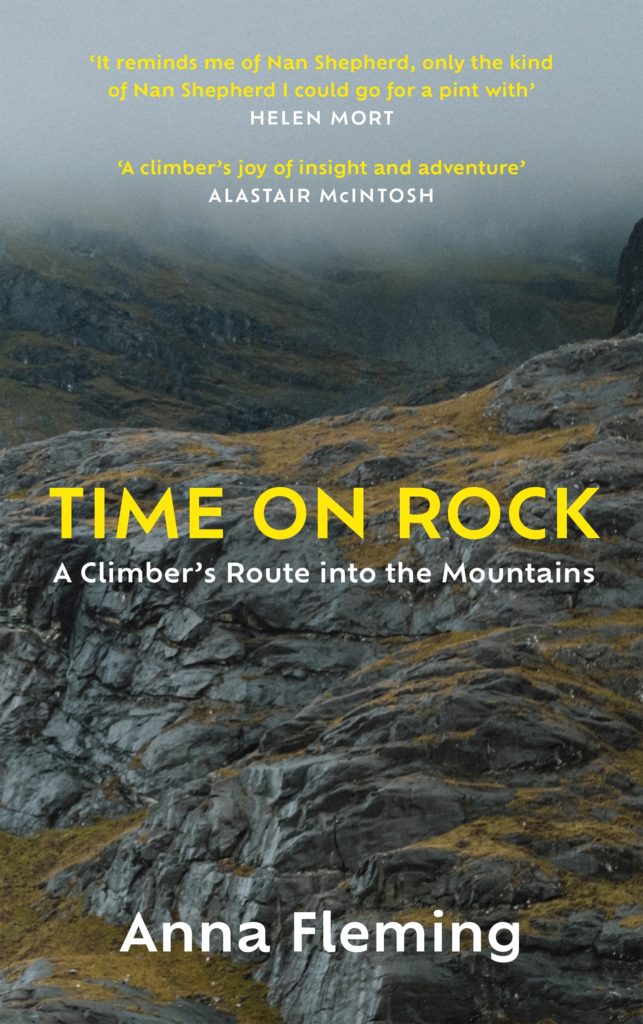Anna Fleming’s ‘Time on Rock: A Climber’s Route into the Mountains’ — a rock-climber’s eye view of the natural world, published today by Canongate — is our January Book of the Month. Read an extract below.

Each rock-type speaks its own language, which is shaped, in part, by its geology. Different stones are composed of distinctive minerals, giving rise to particular textures and densities of rock which erode in its own characteristic style. Climbers hone in on this superficial matter, their focus drawn to the surface, the meeting place of weather and geology. Rocks have patterns, and climbers learn to read these patterns by mapping their body to the stone. In time, all the playful practice of exploration and experimentation builds up into a vocabulary and then you become fluent in the rock.
Some rocks are easier to read than others. There are some that you get on and take to immediately, finding a ready flow of comprehension. Others are more difficult. Some rocks have a complex grammar that you struggle to get your head around and as you make your way into that alien language, you meet frequent stumbling blocks.
Gritstone has an air of simplicity. Unlike rhyolite and limestone – which can weather into a mosaic of holds and fissures – gritstone is not cluttered with excessive detail. It is typically laid out in rounded breaks, cracks, smooth walls and sculpted forms. The routes tend to be short – many a mere ten or twenty metres – and scanning these simple looking lines, you predict a sequence of moves, anticipate the challenges and set off.
On the rock, however, you discover your mistakes. Sections that looked blank contain hidden gems and the passages that you thought you would sail through suddenly push, prod and harass you. Like Finnish or Hungarian, gritstone is something of a labyrinth to the non-native speaker. Incompetence is soon laid bare. This is a rock that demands technique.
I am not a native gritstone speaker. I come from a region underscored by Silurian mudstone, a rock that is loose and porous, prone to crumble and shatter. There were no cliffs to play on. Quarried pits appeared here and there, in the oak-woods where the stone had been taken out to build a nearby house or barn, but those tumbledown brambled holes offered little worth climbing. In that rolling landscape of hills, woodland, pheasants, farmers and sheep, there were no proper climbers. We scaled trees and scrambled over gates or barbed-wire fences. That was as far as it went.
Gritstone was the first rock that I properly climbed on, but it did not ignite my passion for climbing. Like so many modern climbers, that began indoors, in the urban environment. Moving away from home to study in Liverpool, some new outdoorsy friends took me down the dock roads to an old church. Inside, the pews had gone and there was no font or altar – the towering walls had been repurposed for a different observance. We warmed up in the crypt, clinging to coloured plastic-resin holds, traversing around the room, ducking our heads for the low ceiling. Then we headed up into the nave where vast lines stretched up right up to the rafters.
When I first reached the top, my heart pounded. The ground was miles away. What was I doing up here? How would I get down? The action of reaching and stretching between the coloured holds to pull myself up the wall was so absorbing that I hadn’t noticed how high I had climbed until suddenly I ran out of holds and was at the top, cheeks glowing with triumph while my stomach swooped.
With repeat trips up to the rafters, I soon forgot the height and began to find rhythm, sequence, coordination and power. I discovered that good climbing flowed. Climbing was dancing and it left a very real impression upon the body. For days afterwards, I felt the strain in my arms, shoulders, legs and stomach. Such aches were oddly pleasurable. The pain that came after a good session – all of those deep-muscle aches and twinges, the struggle to raise a glass or put on a coat – taught me about my physique. On the wall I became a network of muscles, limbs, senses, nerves, cells and neurons; an active, thinking, sensing being. Indoor climbing gave me a new map of my body. Forget body-image – this was body-physical.
*
‘Time on Rock’ is out now and available here (£14.99).